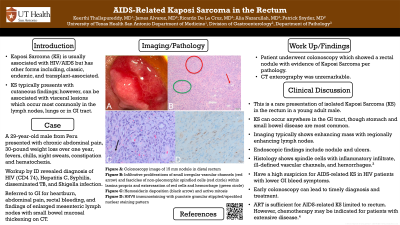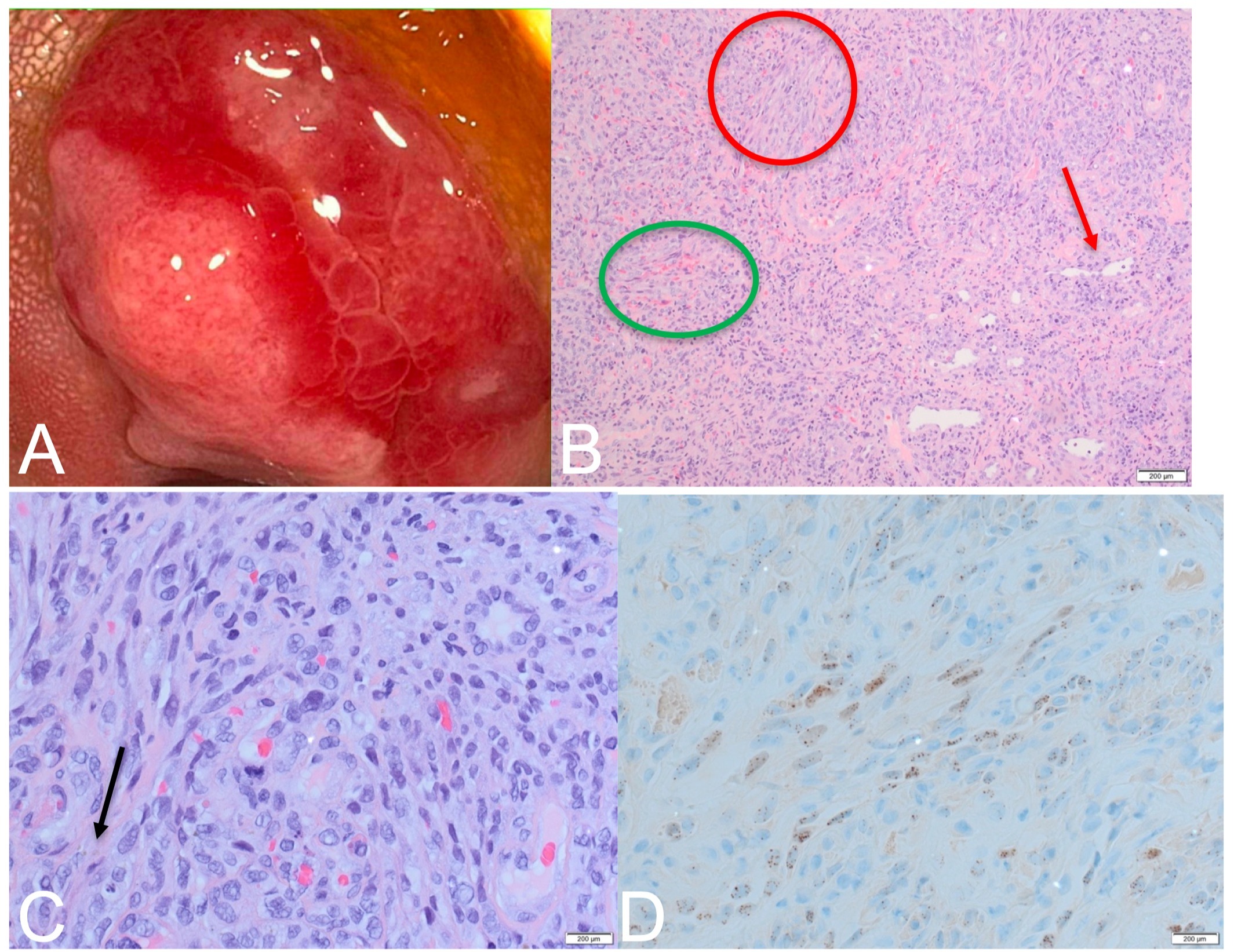Tuesday Poster Session
Category: Colon
P3090 - AIDS-Related Kaposi Sarcoma in Rectum
Tuesday, October 24, 2023
10:30 AM - 4:00 PM PT
Location: Exhibit Hall

Has Audio

Keerthi Thallapureddy, MD
UT Health San Antonio
San Antonio, TX
Presenting Author(s)
Keerthi Thallapureddy, MD1, James Alvarez, MD2, Ricardo De La Cruz, MD1, Alia Nazarullah, MD3, Patrick Snyder, MD3
1UT Health San Antonio, San Antonio, TX; 2University of Texas Health Science Center-San Antonio, San Antonio, TX; 3University of Texas Health Science Center at San Antonio, San Antonio, TX
Introduction: Kaposi Sarcoma (KS) is a vascular tumor caused by human herpesvirus 8 (HHV8) commonly seen in patients with acquired immunodeficiency syndrome (AIDS) and presenting as cutaneous and/or visceral lesions. We present a rare case of a young man with newly diagnosed AIDS who was found to have symptomatic KS localized to the rectum.
Case Description/Methods: A 29-year-old man from Peru presented to the emergency department with chronic abdominal pain, 30-pound weight loss over one year, fevers, chills, night sweats, constipation and hematochezia. Computed tomography (CT) of the abdomen showed enlarged mesenteric lymph nodes with small bowel mucosal thickening. He was found to have human immunodeficiency virus (HIV) with a CD4 count of 74 and laboratory and imaging evidence of Hepatitis C, Syphilis, disseminated Tuberculosis, and Shigella infection. He was referred to Gastroenterology, and colonoscopy showed patchy colonic inflammatory changes and a rectal nodule (Figure A) with biopsies (Figures B-D) positive for HHV8, confirming a diagnosis of KS. The patient was treated with combination antiretroviral therapy (ART) and was referred to Hematology/Oncology for further care.
Discussion: KS is most commonly seen in conjunction with AIDS, though there are also endemic, classic and organ transplant-associated forms. Patients with KS may present with cutaneous and/or gastrointestinal (GI) or extraintestinal visceral lesions. Visceral disease typically presents asymptomatically and is often discovered incidentally. GI involvement is present in 40% of patients at the time of diagnosis and can occur anywhere from the oropharynx to the rectum but most commonly in the stomach and small bowel. Abdominal pain, diarrhea, proctalgia and rectal bleeding are the most common presenting symptoms. Cross sectional imaging may show an enhancing mass with regional enhancing lymph nodes, and endoscopy may show ulcers or nodules of a range of colors. Our patient presented with abdominal pain and hematochezia with non-specific CT findings of enlarged mesenteric lymph nodes, and KS was only discovered upon performing colonoscopy. Treatment involves ART in virtually all patients with AIDS-related KS and may additionally include local topical, chemotherapy or radiotherapy or systemic chemotherapy in select cases. This case demonstrates a rare presentation of KS involving the rectum and highlights the need to be aware of GI KS as a diagnostic possibility in patients with AIDS.

Disclosures:
Keerthi Thallapureddy, MD1, James Alvarez, MD2, Ricardo De La Cruz, MD1, Alia Nazarullah, MD3, Patrick Snyder, MD3. P3090 - AIDS-Related Kaposi Sarcoma in Rectum, ACG 2023 Annual Scientific Meeting Abstracts. Vancouver, BC, Canada: American College of Gastroenterology.
1UT Health San Antonio, San Antonio, TX; 2University of Texas Health Science Center-San Antonio, San Antonio, TX; 3University of Texas Health Science Center at San Antonio, San Antonio, TX
Introduction: Kaposi Sarcoma (KS) is a vascular tumor caused by human herpesvirus 8 (HHV8) commonly seen in patients with acquired immunodeficiency syndrome (AIDS) and presenting as cutaneous and/or visceral lesions. We present a rare case of a young man with newly diagnosed AIDS who was found to have symptomatic KS localized to the rectum.
Case Description/Methods: A 29-year-old man from Peru presented to the emergency department with chronic abdominal pain, 30-pound weight loss over one year, fevers, chills, night sweats, constipation and hematochezia. Computed tomography (CT) of the abdomen showed enlarged mesenteric lymph nodes with small bowel mucosal thickening. He was found to have human immunodeficiency virus (HIV) with a CD4 count of 74 and laboratory and imaging evidence of Hepatitis C, Syphilis, disseminated Tuberculosis, and Shigella infection. He was referred to Gastroenterology, and colonoscopy showed patchy colonic inflammatory changes and a rectal nodule (Figure A) with biopsies (Figures B-D) positive for HHV8, confirming a diagnosis of KS. The patient was treated with combination antiretroviral therapy (ART) and was referred to Hematology/Oncology for further care.
Discussion: KS is most commonly seen in conjunction with AIDS, though there are also endemic, classic and organ transplant-associated forms. Patients with KS may present with cutaneous and/or gastrointestinal (GI) or extraintestinal visceral lesions. Visceral disease typically presents asymptomatically and is often discovered incidentally. GI involvement is present in 40% of patients at the time of diagnosis and can occur anywhere from the oropharynx to the rectum but most commonly in the stomach and small bowel. Abdominal pain, diarrhea, proctalgia and rectal bleeding are the most common presenting symptoms. Cross sectional imaging may show an enhancing mass with regional enhancing lymph nodes, and endoscopy may show ulcers or nodules of a range of colors. Our patient presented with abdominal pain and hematochezia with non-specific CT findings of enlarged mesenteric lymph nodes, and KS was only discovered upon performing colonoscopy. Treatment involves ART in virtually all patients with AIDS-related KS and may additionally include local topical, chemotherapy or radiotherapy or systemic chemotherapy in select cases. This case demonstrates a rare presentation of KS involving the rectum and highlights the need to be aware of GI KS as a diagnostic possibility in patients with AIDS.

Figure: Figure A: Colonoscopy image of 15 mm nodule in distal rectum;
Figure B: Infiltrative proliferations of small irregular vascular channels (red arrow) and fascicles of non-pleomorphic spindled cells (red circle) within lamina propria and extravasation of red cells and hemorrhage (green circle);
Figure C: Hemosiderin deposition (black arrow) and active mitosis;
Figure D: HHV8 immunostaining with punctate granular stippled/speckled nuclear staining pattern.
Figure B: Infiltrative proliferations of small irregular vascular channels (red arrow) and fascicles of non-pleomorphic spindled cells (red circle) within lamina propria and extravasation of red cells and hemorrhage (green circle);
Figure C: Hemosiderin deposition (black arrow) and active mitosis;
Figure D: HHV8 immunostaining with punctate granular stippled/speckled nuclear staining pattern.
Disclosures:
Keerthi Thallapureddy indicated no relevant financial relationships.
James Alvarez indicated no relevant financial relationships.
Ricardo De La Cruz indicated no relevant financial relationships.
Alia Nazarullah indicated no relevant financial relationships.
Patrick Snyder indicated no relevant financial relationships.
Keerthi Thallapureddy, MD1, James Alvarez, MD2, Ricardo De La Cruz, MD1, Alia Nazarullah, MD3, Patrick Snyder, MD3. P3090 - AIDS-Related Kaposi Sarcoma in Rectum, ACG 2023 Annual Scientific Meeting Abstracts. Vancouver, BC, Canada: American College of Gastroenterology.
